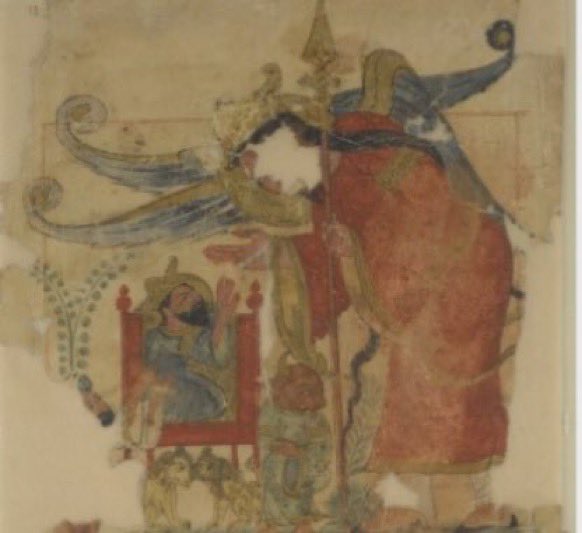Modern astrology emphasizes the zodiac, (ie people identify with their sign) but in medieval astrology from the Islamic world, the planets far outweigh the zodiac, with each influencing various aspects of life.
A thread on the planets in Islamic astrology:
A thread on the planets in Islamic astrology:
Saturn (Al Zuhal) is male and black. Disagreeable and acidic, it rules exile, poverty, failure, enslavement, and lamentation. It is miserly and suspicious. The domain of builders, farmers, grave-diggers, fathers, grandfathers, demons, and magicians.
The image of Saturn is a seated old man with a wolf with a pick ax
The angel of Saturn is Azra’il
The angel of Saturn is Azra’il
Jupiter (Al Mushtari) is male and sweet. Its domain is friendliness, peace, religion, charity, wealth, and levity. It is devout and eager for education, honorable, and trusting. It rules bankers, administrators, priests, dreamers, children and grandchildren, kings, & courtiers.
The image of Jupiter is an armored man with a rosary in his hands.
The angel of Jupiter is Sarfa’il.
The angel of Jupiter is Sarfa’il.
Mars (Al Marrikh) is male and red. It rules ruin of business, false testimony, and quarrelsome companions. It is fast, licentious in an evil way, bold, but violent. Rules blacksmiths, grave-robbers, highwaymen, soldiers, slavers, seller of hounds, and brothers.
The image of Mars is a man with two lions, or a man holding a decapitated head.
The angel of Mars is Thatgas
The angel of Mars is Thatgas
Sun (al Shams) male and shining yellow. The sun’s domain is lordships, it’s position can reveal the success of a government or signs of rebellion. It is chaste, intelligent, quick-tempered, but cools after. Grants good reputation, receiving honors, & rules fathers & magistrates
The image of the Sun is a man seated on a wheeled shield drawn by oxen.
The angel of the Sun is Ruqiya’il
The angel of the Sun is Ruqiya’il
Venus (Al Zuhara) is female. It is voluptuous and sweet, colored white and green. It rules leisure, jest, dancing, pleasure, chess, excesses, is fond sexual delight and “sodomy,” friendly, and tender. Also perfumers, bazaars, musicians, wives, adulterers, & courtesans,
The image of Venus is a seated woman holding up a mirror.
The angel of Venus is Inya’il
The angel of Venus is Inya’il
Mercury (al Utarid) is male and rules over manners, logic, memory, lies, excess spending (especially on women), calumny, and business. It is changeable and is the domain of merchants, barbers, philosophers’ younger brothers, and tax-collectors.
Mercury’s image is a seated young man holding a serpent and a tablet.
The angel of Mercury is Mika’il
The angel of Mercury is Mika’il
Moon (Al Qamar) is female and brilliant blue. It rules over anxiety re: health, fickleness, and good spirits. It's adaptable, timid, & good-hearted. Rules prisoners, water-diviners, mothers & aunts
The image of the Moon is a man in a chariot with a spear.
The angel of the Moon is Jibra’il or Mansa
The angel of the Moon is Jibra’il or Mansa
There is also the invisible“planet” or star that is included in most Islamic astrological treaties, al-tinnin ("the dragon"), or Jawzahr, which is generally found in various drawings and artwork.
An astrologer would read the planet as the actors, the zodiac as adding a shade of interpretation, and the house as the sphere it is all taking place in.
So, Jupiter in Leo in the 9th house would indicate a feral, but regal professor or lord.
So, Jupiter in Leo in the 9th house would indicate a feral, but regal professor or lord.
The images of the planets were reflections of the spirits each planet. Some texts claim each planet have seven spirits. Sometimes viewed as angels, or djinn/jinn, or as separate entities.
The images are found in manuscripts and on talismans
I'll expand on these in the future
The images are found in manuscripts and on talismans
I'll expand on these in the future
It should be noted that astrology was contested and while many philosophers like Al Kindi saw its study as the means by which to understand God’s action, many others denounced it. I use “Islamic” here as a descriptor of an intellectual tradition, not orthodox religion.
In the coming weeks, I’ll expand further on the different aspects of Islamic astrology, from the different studies, the use of prognostication, and some less known bits.
• • •
Missing some Tweet in this thread? You can try to
force a refresh








